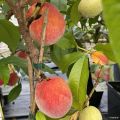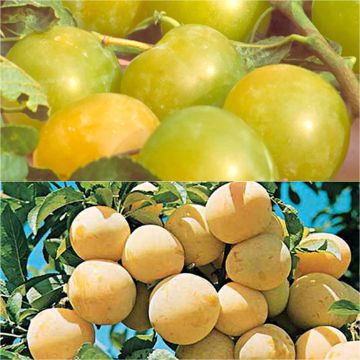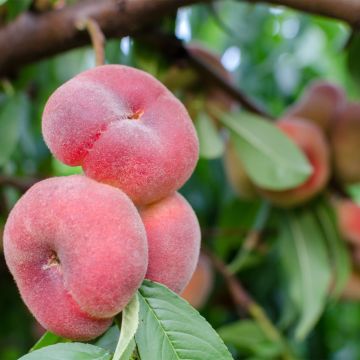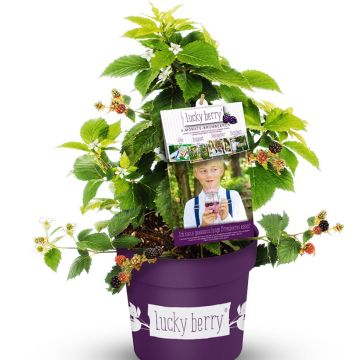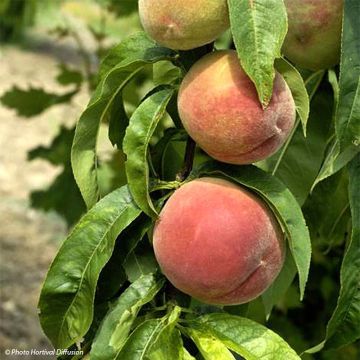

Dwarf Yellow Fruit Tree Collection
Dwarf Yellow Fruit Tree Collection
Fruit Me® Apricot Me Pending, Fruit Me® Peach Me Red, Fruit Me® Necta Me
apricot, peach and nectarine
Special offer!
Receive a €20 voucher for any order over €90 (excluding delivery costs, credit notes, and plastic-free options)!
1- Add your favorite plants to your cart.
2- Once you have reached €90, confirm your order (you can even choose the delivery date!).
3- As soon as your order is shipped, you will receive an email containing your voucher code, valid for 3 months (90 days).
Your voucher is unique and can only be used once, for any order with a minimum value of €20, excluding delivery costs.
Can be combined with other current offers, non-divisible and non-refundable.
This plant carries a 6 months recovery warranty
More information
We guarantee the quality of our plants for a full growing cycle, and will replace at our expense any plant that fails to recover under normal climatic and planting conditions.
Collection items (3 plants)
-
Prunus armeniaca Fruit Me Apricot Me Pending - Apricot Tree
Price per single item: 39,50 €Find out more -
Prunus persica Fruit Me Peach Me Red - Dwarf Nectarine Peach Tree
Price per single item: 39,50 €Find out more -
Prunus persica Fruit Me Necta Me - Dwarf Nectarine Peach Tree
Price per single item: 39,50 €Find out more
Description
This collection of self-fertile Fruit Me dwarf fruit trees with yellow fruits allows for delicious harvests of apricots, peaches, and nectarines even in a small garden or in containers on a terrace. It brings together 3 excellent varieties: 'Fruit Me Apricot Me Pending', 'Fruit Me Peach Me Red', and 'Fruit Me Necta Me'. Grown in pots, these small trees do not exceed 2 m (7ft) high and have a spread of 1.50 m (5ft). They are highly decorative with their spring blossom, self-fertile, and their beautiful tasty fruits can be harvested from mid-July until August. The small size of these trees also makes harvesting easier.
This collection consists of:
- x 1 Fruit Me Dwarf Apricot Tree 'Apricot Me Pending': a variety with a beautiful pinkish-white blossom in March. It produces oblong apricots that are 5 cm (2in) in diameter, weighing approximately 40 to 50 grams. The velvety, orange skin, orange, speckled with red, encloses firm, juicy, sweet flesh with a subtle acidity. Harvest from mid-July.
- x 1 Fruit Me Dwarf Peach Tree 'Peach Me Red': very beautiful bright pink blossom in March-April. This variety produces round peaches with velvety skin, 5-6 cm (2in) in diameter, reddish-orange when ripe, with yellow flesh that is sweet and tasty. Harvest in July-August, earlier or later depending on the region.
- x 1 Fruit Me Dwarf Nectarine Tree 'Necta Me': pink blossom in March-April. This variety produces round nectarines that are 5-6 cm (2in) in diameter covered with a smooth, yellow skin, strongly tinged with red. Their golden yellow flesh is juicy, sweet, and fragrant. Harvest from mid-July to August.
'Fruit Me' is a series of semi-dwarf fruit trees that are quite revolutionary, recently developed in Spain. All the fruit trees in this range are grafted onto a state-of-the-art rootstock that adapts to the available soil volume while allowing for high-quality fruiting from the first years of cultivation. Fruit Me trees are also self-fertile, easy to grow, hardy, reliable, and less susceptible to diseases. One tree of each variety is sufficient to obtain fruits. Pruning is not necessary. In the ground, these fruit trees will reach a height of less than 3 m (10ft) with a spread of approximately 1.5 m (5ft).
You can plant these fruit trees from October to March in the ground. If you grow them in containers, planting is possible throughout the year except during frost or heatwaves. They will need a sunny exposure to flower and fruit abundantly. In the ground, space the plants at least 1 m (3ft) apart, or even 1.50 m (5ft). Dig a wide planting hole at least 3 times the volume of the rootball. Add organic matter (compost, potting soil...) and a slow-release fertiliser such as horn meal. Do not bury the graft union. Stake if necessary. Water abundantly, even in winter and even if it rains.
In containers: choose a large volume container, 30 to 50 litres, with drainage holes. Use a mixture of topsoil and high-quality potting soil. Regular applications of fruit tree fertiliser will be necessary, as well as regular watering, to obtain generous harvests.
Plant habit
Fruit
Flowering
Foliage
Botanical data
Fruit Me® Apricot Me Pending, Fruit Me® Peach Me Red, Fruit Me® Necta Me
Rosaceae
apricot, peach and nectarine
Cultivar or hybrid
Other Our fruit tree and berry bush collection
View all →Planting and care
Plant these dwarf fruit trees in the ground or in a pot. Choose a sunny location. They need fertile, loose soil that doesn't dry out too much in summer. Do not bury the graft union. Water thoroughly the first time, even in winter, even if it's raining. Fruit trees are best planted between October and March, outside of the freezing period. You can add a small handful of wood ash, rich in potash, during winter, which will improve fruiting. These fruit trees do not require specific pruning, only the removal of dead wood.
Watch out for possible attacks from aphids and other pests during the season. Only keep harvested fruits.
Planting period
Intended location
Care
Planting & care advice
This item has not been reviewed yet - be the first to leave a review about it.
Similar products
Haven't found what you were looking for?
Hardiness is the lowest winter temperature a plant can endure without suffering serious damage or even dying. However, hardiness is affected by location (a sheltered area, such as a patio), protection (winter cover) and soil type (hardiness is improved by well-drained soil).

Photo Sharing Terms & Conditions
In order to encourage gardeners to interact and share their experiences, Promesse de fleurs offers various media enabling content to be uploaded onto its Site - in particular via the ‘Photo sharing’ module.
The User agrees to refrain from:
- Posting any content that is illegal, prejudicial, insulting, racist, inciteful to hatred, revisionist, contrary to public decency, that infringes on privacy or on the privacy rights of third parties, in particular the publicity rights of persons and goods, intellectual property rights, or the right to privacy.
- Submitting content on behalf of a third party;
- Impersonate the identity of a third party and/or publish any personal information about a third party;
In general, the User undertakes to refrain from any unethical behaviour.
All Content (in particular text, comments, files, images, photos, videos, creative works, etc.), which may be subject to property or intellectual property rights, image or other private rights, shall remain the property of the User, subject to the limited rights granted by the terms of the licence granted by Promesse de fleurs as stated below. Users are at liberty to publish or not to publish such Content on the Site, notably via the ‘Photo Sharing’ facility, and accept that this Content shall be made public and freely accessible, notably on the Internet.
Users further acknowledge, undertake to have ,and guarantee that they hold all necessary rights and permissions to publish such material on the Site, in particular with regard to the legislation in force pertaining to any privacy, property, intellectual property, image, or contractual rights, or rights of any other nature. By publishing such Content on the Site, Users acknowledge accepting full liability as publishers of the Content within the meaning of the law, and grant Promesse de fleurs, free of charge, an inclusive, worldwide licence for the said Content for the entire duration of its publication, including all reproduction, representation, up/downloading, displaying, performing, transmission, and storage rights.
Users also grant permission for their name to be linked to the Content and accept that this link may not always be made available.
By engaging in posting material, Users consent to their Content becoming automatically accessible on the Internet, in particular on other sites and/or blogs and/or web pages of the Promesse de fleurs site, including in particular social pages and the Promesse de fleurs catalogue.
Users may secure the removal of entrusted content free of charge by issuing a simple request via our contact form.
The flowering period indicated on our website applies to countries and regions located in USDA zone 8 (France, the United Kingdom, Ireland, the Netherlands, etc.)
It will vary according to where you live:
- In zones 9 to 10 (Italy, Spain, Greece, etc.), flowering will occur about 2 to 4 weeks earlier.
- In zones 6 to 7 (Germany, Poland, Slovenia, and lower mountainous regions), flowering will be delayed by 2 to 3 weeks.
- In zone 5 (Central Europe, Scandinavia), blooming will be delayed by 3 to 5 weeks.
In temperate climates, pruning of spring-flowering shrubs (forsythia, spireas, etc.) should be done just after flowering.
Pruning of summer-flowering shrubs (Indian Lilac, Perovskia, etc.) can be done in winter or spring.
In cold regions as well as with frost-sensitive plants, avoid pruning too early when severe frosts may still occur.
The planting period indicated on our website applies to countries and regions located in USDA zone 8 (France, United Kingdom, Ireland, Netherlands).
It will vary according to where you live:
- In Mediterranean zones (Marseille, Madrid, Milan, etc.), autumn and winter are the best planting periods.
- In continental zones (Strasbourg, Munich, Vienna, etc.), delay planting by 2 to 3 weeks in spring and bring it forward by 2 to 4 weeks in autumn.
- In mountainous regions (the Alps, Pyrenees, Carpathians, etc.), it is best to plant in late spring (May-June) or late summer (August-September).
The harvesting period indicated on our website applies to countries and regions in USDA zone 8 (France, England, Ireland, the Netherlands).
In colder areas (Scandinavia, Poland, Austria...) fruit and vegetable harvests are likely to be delayed by 3-4 weeks.
In warmer areas (Italy, Spain, Greece, etc.), harvesting will probably take place earlier, depending on weather conditions.
The sowing periods indicated on our website apply to countries and regions within USDA Zone 8 (France, UK, Ireland, Netherlands).
In colder areas (Scandinavia, Poland, Austria...), delay any outdoor sowing by 3-4 weeks, or sow under glass.
In warmer climes (Italy, Spain, Greece, etc.), bring outdoor sowing forward by a few weeks.































